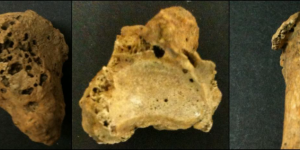The ethics of primatology is a complex issue, and one which has received a lot of media attention in recent years, as well as becoming increasingly relevant to archaeological studies. Within this area, it has particular significance to the study of human evolution, and in recent years there has been an increase in non-human primate research in an attempt to further our understanding of hominin technology and behaviour (Haslam et al. 2009, 339).
The observation of non-human primates (Figure 1), known as primatology, consists of the study of their behavioural traits, anatomy and cognitive abilities within various environments ranging from natural habitats and sanctuaries through to laboratories. The great (non-human) apes inhabit Africa, Borneo and Sumatra, and other ape species live in many regions of Southeast Asia, whilst prosimians are found within Madagascar, Africa and Asia (Swindler 2002, 1). The remaining primate species, Homo sapiens, is the only living hominid and is located in nearly every region of the world. Therefore, the study of extant (and even extinct) non-human primates allows for an understanding about human evolution, which shall be addressed during the course of this article.
The areas that will be discussed draw on existing news articles that have played a pivotal role in bringing the issues surrounding the study and treatment of animals to the forefront in recent years. As a result, there is a degree of repetition between the overview given here and these media publications, all of which I strongly encourage you to read, and to convey the messages that they impart.
The study and treatment of animals once again became prominent within the media following the publication of a report carried out by the Council of Councils Working Group in January of this year (2013). The report, titled ‘Chimpanzees in Biomedical and Behavioural Research: Assessing the Necessity’, focused on the work carried out by the US National Institutes of Health (NIH), who were told to dismantle their 10-year-old colony that consisted of 360 chimpanzees. All but 50 members of this colony were to be retired to a national sanctuary, following the argument that 50 chimpanzees is a more than adequate number with which to carry out future research (NIH News 2012; Council of Councils Working Group 2013, 36; Wadman 2013). The NIH was also instructed to end half of their 22 biomedical and behavioural experiments (Wadman 2013).
The overall assessment for the use of chimpanzees in biomedical and behavioural research found that the experiments did not meet the established criteria from the report released in December 2011 by the Institute of Medicine (IOM); the report also highlighted the idea that most chimpanzee based research was unnecessary. It was advised that chimpanzee-based research should only be permitted if the studies were beneficial to public health, and performing these studies on humans was deemed unethical (Wadman 2013). The advisors also recommended that the animals retained for research must be maintained in socially and physically appropriate habitats.
Despite this news being welcomed by animal-rights activists, it has been less enthusiastically received by those who work within these laboratory environments. The Texas Biomedical Research Institute (TBRI) in San Antonio issued a statement saying that the report’s recommendations “will slow urgently needed medical advances necessary to prevent and treat human diseases that afflict millions of Americans as well as hundreds of millions of people living in other countries” (Wadman 2013).
It is this attempt to refocus the study of chimpanzees, and other animals, to the benefits to humanity, and often pulling on heart strings by referring to the increased possibility of death (often in more extreme cases), that leads to many people being blindsided by the effects these studies have on both individual and groups of animals. Therefore, it is vital that both the benefits and disadvantages be weighed up when analysing the ethical issues that surround the study of animals.
Despite the results of this report having a significant impact on medical research, the impact is likely to be less extreme in regards to the study of human evolution. This is due to the majority of primatology research of the great apes being carried out in their natural habitat, such as the work done by Jane Goodall (http://www.janegoodall.org.uk). Over the years, ten key aspects (English 2011) have emerged regarding what we have learned about humans through the study of non-human primates:
- Human nature
- Discoveries in medicine
- Possible origins of language
- Cultural transmission
- Learning and cognition
- Stem cell technology
- Possible origins of tool use
- Insight into group sociality
- Genetics and human biology
- Possible origin of bipedalism
In order to further our understanding of these ten aspects, we have studied chimpanzees, our closest living relative, in laboratories, zoos, conservation areas (enclosures) and (the most humane method) in their natural habitat.
The study of these species includes Bonobos (a type of chimpanzee) and Japanese macaques that have been studied in an attempt to understand these aspects further. These studies showed that occasionally they move in a bipedal manner to carry objects and in some instances they have been trained to walk on two feet (D’Août et al. 2004, 357 and 258; Nakatsukasa et al. 2004, 249-250 and 256). However, while this is not identical to humans, it does provide a perspective into circumstances where bipedalism has adaptive benefits and at what energetic cost (D’Août et al. 2004, 360; Nakatsukasa et al. 2004, 254-255; Cachel 2006, 278).
In addition to this there have been several prominent cases regarding the study of chimpanzees and language: The Gua and Vicki projects, The Washoe Project and Project Nim (Gardner 1989; Gill 1997; Hess 2008). Project Nim was the study of a chimpanzee, who in 1973 was taken from his mother at 2 weeks old to be raised as a human child. He was named Nim Chimpsky after Noam Chomsky, whose thesis that language is only inherent in humans they were trying to refute.
Dr. Herb Terrace sought to prove that Nim could learn to communicate with sign language if he was raised and nurtured like a human child, and subsequently Nim was the subject of a sign language acquisition study in which he succeeded in learning 125 signs. Despite this, Terrace concluded that Nim had not acquired the suitable skills that he was prepared to designate worthy of the term ‘language’ (as defined by Noam Chomsky), even though Nim had learned to repeat his trainers' signs in the appropriate contexts. It was argued afterwards that the conditions in which Nim was taught and how he was treated degraded over the course of the experiment and he was treated increasingly less like a human child (Gardner 1989, 21-22).
This experiment remains prominent, and in 2011 a documentary that used actual footage from some of the sessions called ‘Project Nim’ was produced. Alongside this, accounts of Project Nim following the end of the research are still a basis of discussion about the ethics of teaching a chimp to be ‘human’, only to then be passed on and left caged and isolated.
On a visit to see Nim, one of his past carers was greeted by signs for help and for the key so he could get out of the cage. If Nim was capable of signing for help and showing signs of distress from being caged, the implication is that other animals, not just chimpanzees, are distressed, but are unable to communicate their wish to be released from captivity. Therefore the results of Project Nim, following the events after the research ended in which Nim was caged and isolated, were far more extreme than Terrace and his team could have anticipated. The involvement of the media and the general public to remove Nim from captivity brought to light the notion that animals should have rights, including the right to legal protection from research.
The Nim Project was the successor to the Washoe Project: a female chimpanzee who was the first non-human to learn American Sign Language (ASL) and communicate with those carrying out the research experiment on animal language acquisition (Gill 1997, 9). Washoe was not bred in captivity; instead she was captured in 1965 from West Africa by the US Air Force for the space program. It was not until 1967 that Allen and Beatrix Gardner established the project to teach Washoe ASL and removed her from the space program research (Gardner 1989).
It was decided that sign language was the best option for teaching a non-human primate how to communicate, following the failures of both the Gua and Vicki projects (in which attempts were made to teach chimpanzees how to imitate vocal languages) (Harley 2007, 52). The failure of this is due to chimpanzees being physically unable to produce the vocal sounds that are required for oral language. Instead, the Gardners decided to utilise the natural ability of chimpanzees to create diverse body gestures within the wild.
During the experiment Washoe learnt around 350 words and even managed to teach her adopted son Loulis some ASL (Gill 1997, 11). Like Nim Chimpsky, Washoe was raised in the same fashion as a human child and lived within a human family unit (Gardner 1989; Gill 1997). However, despite this aiding research, both projects (like many others) appear to have lacked foresight. When the research was completed they were dispatched to other research units and were no longer treated in the same way. They were still considered too dissimilar to humans to warrant the same consideration a human child is given and yet they were too far removed from their natural heritage to be able to return to a chimpanzee community.
Sadly, Nim died at a much earlier age than Washoe, possibly due to the stresses and trauma during and after the original research had ended. Washoe passed away at the Chimpanzee and Human Communication Institute on October 30th 2007, whilst Nim died on March 10th 2000 at Black Beauty Ranch in Texas; he should have lived for at least another 20 years (Hess 2008).
Despite the medicinal benefits that these studies are having within the modern world, the disadvantages to chimpanzees is becoming more apparent and is beginning to gain prominence within the media. This is evident within the cases of Nim and Washoe, who were studied in an attempt to satisfy our curiosity and gain knowledge about the development of language, which has contributed no known benefits to humanity. It might even be said that, at the most basic level we were just trying to teach non-human primates to talk.
It is argued that human contact with not only chimpanzees, but also the other great apes and animals that we take from their natural habitats, is causing high levels of stress and could have unforeseen consequences. This may affect their behavioural patterns, and has been noted in zoos in the form of an increasing number of failed attempts to raise young (Redmond 2008).
The question should therefore be asked that if the behaviour of studied animals is changing due to human interaction, then is what we are learning accurate and even beneficial to what it is we are trying to discern? As a result, elements of primatology studies need to be re-examined in order to assess whether the data retrieved is accurate enough to provide us with a reliable comparison for the study of human evolution.
All of the topics and cases discussed are much more complex than I can do justice to here and I implore you to read around these subjects yourself and formulate your own view on the ethics that surround the study of chimpanzees. Do the benefits really outweigh the cost?
Bibliography
- anon. (2013) ‘Council of Councils Working Group on the Use of Chimpanzees in NIH-Supported Research’. Council of Councils Working Group. Available at: http://dpcpsi.nih.gov/council/pdf/FNL_Report_WG_Chimpanzees.pdf [Accessed 28th February 2013]
- Cachel, S. (2006) Primate and Human Evolution. Cambridge: Cambridge University Press
- D’Août, K., Vereecke, E., Schoonaert, K., De Clercq, D., Van Elsacker, L. and Aerts, P. (2004) ‘Locomotion in bonobos (Pan paniscus): differences and similarities between bipedal and quadrupedal terrestrial walking, and a comparison with other locomotor modes’. Journal of Anatomy. 204 (5). 353-361
- English, M. (2011) ‘10 Things About Humans We've Learned Studying Primates’. Discovery. Available at: http://dsc.discovery.com/tv-shows/curiosity/topics/10-things-about-human... [Accessed 28th February 2013]
- Gardner, R. A. (1989) Teaching Sign Language to Chimpanzees. Albany: State University of New York Press
- Gill, J. H. (1997) If a Chimp Could Talk: And Other Reflections on Language Acquisition. Arizona: The University of Arizona Press
- Harley, T. A. (2007) The Psychology of Language. Abingdon: Psychology Press
- Haslam, M., Hernandez-Aguilar, A., Ling, V., Carvalho, S., de la Torre, I., DeStefano, A., Du, A., Hardy, B., Harris, J., Marchant, L., Matsuzawa, T., McGrew, W., Mercader, J., Mora, R., Petraglia, M., Roche, H., Visalberghi, E. and Warren, R. (2009) ‘Primate archaeology’. Nature. 460. 339-344
- Hess, E. (2008) ‘Nim Chimpsky: the chimp who thought he was a boy’. The Telegraph. Available at: http://www.telegraph.co.uk/culture/donotmigrate/3553978/Nim-Chimpsky-the... [Accessed 28th February 2013]
- Lersch, T. (2005) ‘Common Chimpanzee in the Leipzig Zoo’. Available at: http://en.wikipedia.org/wiki/File:Schimpanse_zoo-leipig.jpg [Accessed: 27th February 2013]
- Nakatsukasa, M., Ogihara, N., Hamada, Y., Goto, Y., Yamada, M., Hirakawa, T. and Hirasaki, E. (2004) ‘Energetic costs of bipedal and quadrupedal walking in Japanese macaques’. American Journal of Physical Anthropology. 124 (3). 248-256
- NIH (2012) NIH plans to relocate its chimpanzees from New Iberia to the Federal Sanctuary System. National Institute of Health News. Available at: http://www.nih.gov/news/health/dec2012/od-18.htm [Accessed 27th February 2013]
- Redmond, C. (2008) ‘Learning from a mother’s grief’. The Guardian. Available at: http://www.guardian.co.uk/commentisfree/2008/aug/21/animalbehaviour.anim... [Accessed 27th February 2013]
- Swindler, D. R. (2002) Primate Dentition: An Introduction to the Teeth of Non-Human Primates. Cambridge: Cambridge University Press
- Wadman, M. (2013) ‘NIH told to retire most research Chimpanzees: New recommendations could end half of ongoing experiments at US biomedical’. Nature News. Available at: http://www.nature.com/news/nih-told-to-retire-most-research-chimpanzees-... [Accessed 24th January 2013]









